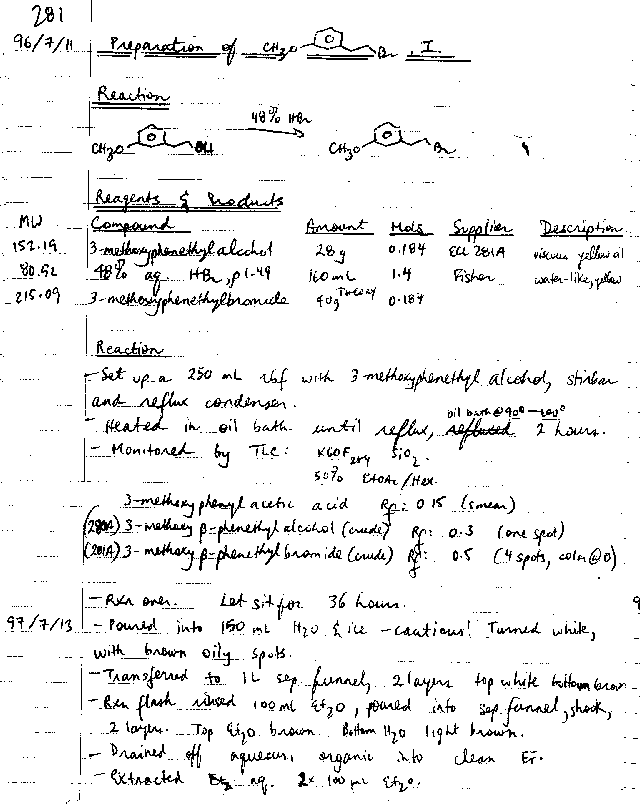

| McMaster University - Chem2O06 Lab Manual | 1997/98 |
There are no formal laboratory write-ups in Chemistry 2O06, and unlike other laboratory courses, you will not hand anything in for marking at the end of each experiment.
Instead, you will learn to keep a laboratory notebook in the style employed by scientists in the real world. Your TA will check your efforts and sign your book at the end of each laboratory period, but you will hand in the notebook for grading only at the end of the course.
A laboratory notebook is a diary of the laboratory work. It should be a bound, hardcover notebook at least 7" x 9" in size. Recordings in the notebook should be written as the experiment is carried out and should be as brief, but concise, as possible. Ultimately, it must contain enough information to trace a mistake or to allow another person to repeat the work exactly as you have done it.
Record in your notebook everything which you do and observe as you carry out the experiment. Write in the past tense, not necessarily with complete sentences as long as there is no ambiguity. Fasten any spectra, tlc patterns, or gc traces obtained during the course of the experiment. Many researchers like to store such additional data in a separate binder or file folders (with everything cross-referenced appropriately), and use Scotch tape to attach a photoreduced copy of the data into the notebook for quick reference.
The first few pages of the notebook are reserved for an Index. Since you will only be carrying out twelve experiments in the course, one page will do. All subsequent pages are numbered. Your index entries should indicate, in a line or two, the experiment and where it is located in the book (i.e., the page number). Enter the title of each experiment, not just "Experiment 1 ...... page 1".
It is a waste of time to spend hours decorating a laboratory notebook, nor will it impress your demonstrator instructor. A notebook should be neat but need not be a work of art. Clarity of procedure and results are what count. Always use a pen, so that errors are crossed out. Never erase an entry in your lab book!
Normally, there will be a few questions at the end of the experiment. They are there for your personal edification, as an indication of some of the things that you should have learned from the experiment. Do NOT answer these in your lab notebook, but be sure to do them - they may return to haunt you!
Finally, all entries in your notebook are to be written in as the experiment proceeds. You can spend a bit of time before the lab filling in some of the initial details (while you're reading over the experiment the night before, for example), but you should not have to spend any time after you've left the lab, other than perhaps to write in your conclusions.
| Title: | Date: _______________ |
| Purpose: | Only necessary if objective is not clear from the title. |
| Equations:* | It is often convenient to indicate amounts of materials, etc. under the equation. |
| Procedure:* | |
| Results:* | Yield, properties of product (m.p., b.p., color, etc.) Calculation of % yield. |
| Conclusions: | Only problem type laboratories generally require conclusions. Usually (but not always), results speak for themselves. |
| References: | Only include sources you have examined. |


| Go to: | Instructions for Printing this Document Chem2O06 Lab Manual Chem2O06 Home Page. |
04sep97; wjl